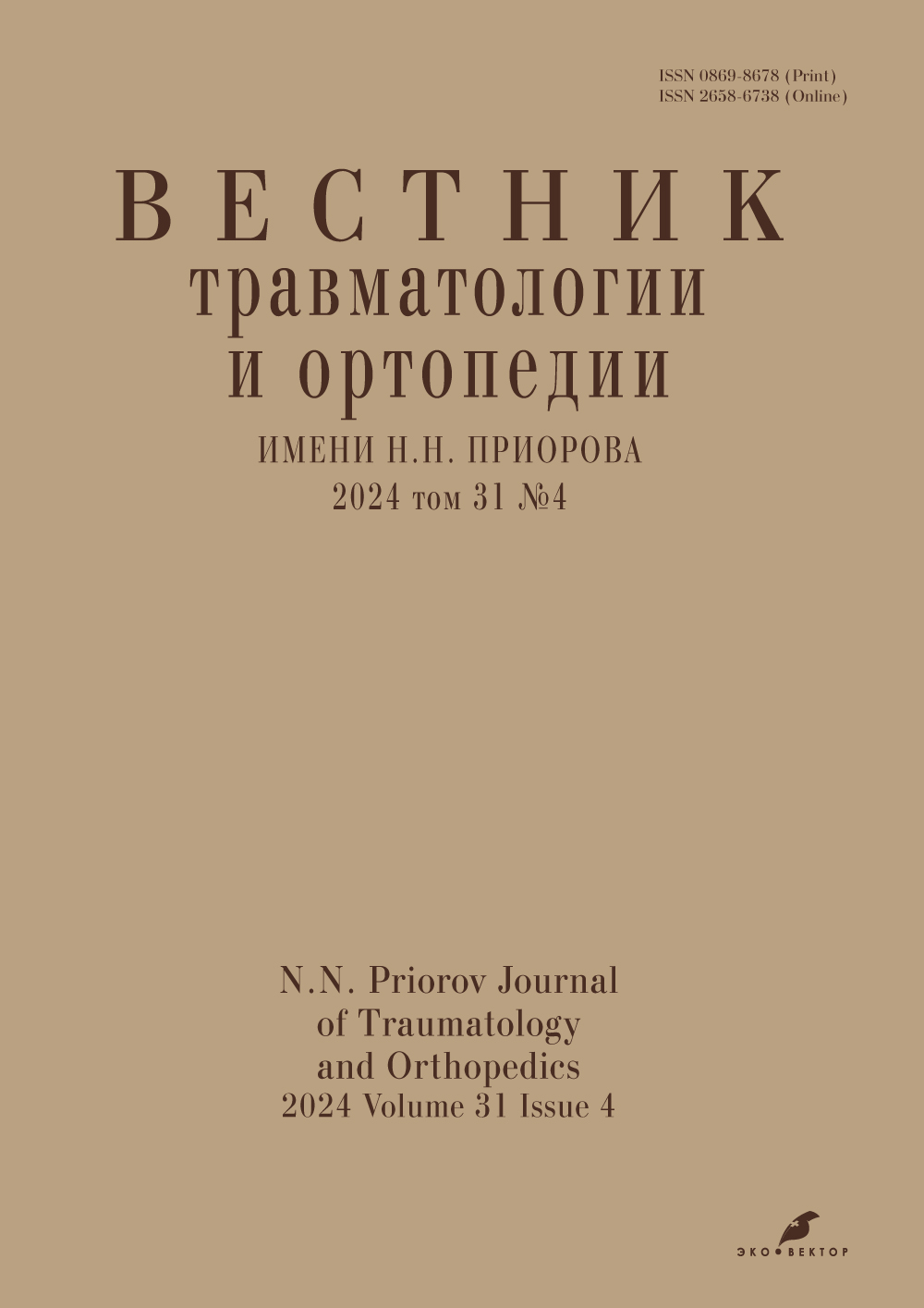The influence of CNN architecture, image size and quality to object detection model on histological specimens
- Authors: Fedosova N.V.1, Berchenko G.N.1, Shugaeva O.B.1, Mashoshin D.V.1, Kochan M.G.1
-
Affiliations:
- Priorov National Medical Research Center of Traumatology and Orthopedics
- Issue: Vol 31, No 4 (2024)
- Pages: 751-758
- Section: SCIENTIFIC REVIEWS
- Submitted: 15.10.2024
- Accepted: 25.10.2024
- Published: 25.12.2024
- URL: https://journals.eco-vector.com/0869-8678/article/view/637087
- DOI: https://doi.org/10.17816/vto637087
- ID: 637087
Cite item
Abstract
Improving convolutional neural network (CNN) quality for object search in histology scans is a long-standing problem that essentially involves selecting the best CNN architecture and creating a high-quality dataset. The efficacy of object detection algorithms is determined by numerous factors, including image quality, image size, and the search object. The primary aim of this study was to identify published studies on the impact of various image characteristics in a training sample and CNN architecture on the quality of a created model. Literature published in the last 5 years was reviewed, which addressed data pre-processing, methodology, requirements to images included in datasets, image preparation for CNN model development, and architecture selection. At the time of the study, there were no requirements to image size, and there was no data on the ratio of object size to image size for the best model performance. Moreover, the selection of neural network architecture is lacking in transparency and algorithmization. In the majority of cases, researchers recommend architectures that they have developed or used themselves, without explaining the reasons and selection criteria or comparing them to alternative options. All these factors significantly complicate the development of CNN models for medical image processing. This paper presents a brief overview of publications that address image preparation for datasets, as well as a potential approach to CNN architecture selection.
Full Text
About the authors
Nina V. Fedosova
Priorov National Medical Research Center of Traumatology and Orthopedics
Email: hard_sign@mail.ru
ORCID iD: 0000-0002-0829-9188
SPIN-code: 5380-3194
MS
Russian Federation, 10 Priorova str., 127299 MoscowGennadiy N. Berchenko
Priorov National Medical Research Center of Traumatology and Orthopedics
Author for correspondence.
Email: berchenko@cito-bone.ru
ORCID iD: 0000-0002-7920-0552
SPIN-code: 3367-2493
MD, Dr. Sci. (Medicine), professor
Russian Federation, 10 Priorova str., 127299 MoscowOlga B. Shugaeva
Priorov National Medical Research Center of Traumatology and Orthopedics
Email: Olga.schugaeva2013@yandex.ru
ORCID iD: 0000-0002-0778-5109
Russian Federation, 10 Priorova str., 127299 Moscow
Dmitriy V. Mashoshin
Priorov National Medical Research Center of Traumatology and Orthopedics
Email: dima_mash@mail.ru
ORCID iD: 0009-0003-5442-5055
SPIN-code: 5981-4084
Russian Federation, 10 Priorova str., 127299 Moscow
Mikhail G. Kochan
Priorov National Medical Research Center of Traumatology and Orthopedics
Email: mk_system@mail.ru
ORCID iD: 0009-0002-0699-1370
Russian Federation, 10 Priorova str., 127299 Moscow
References
- Hort M, Chen Z, Zhang JM, Harman M, Sarro F. Bias Mitigation for Machine Learning Classifiers: A Comprehensive Survey. ACM Journal on Responsible Computing. 2024;1(2):1–52. doi: 10.1145/3631326
- Kamiran F, Toon C. Data preprocessing techniques for classification without discrimination. Knowledge and Information Systems. 2012;33(1):1–33. doi: 10.1007/s10115-011-0463-8
- Li T, Chen K-S, Jin M. Analysis and simulation on imaging performance of backward and forward bistatic synthetic aperture radar. Remote Sensing. 2018;10(11):1676. doi: 10.3390/rs10111676
- Rius A, Cardellach E, Fabra F, et al. Feasibility of GNSS-R ice sheet altimetry in greenland using TDS-1. Remote Sensing. 2017;9(7):742. doi: 10.3390/rs9070742
- Yan J, Liu X, Wang X. Object detection in videos with tubelet proposal networks. In: Proceedings of the IEEE conference on computer vision and pattern recognition. 2017. Р. 727–735. doi: 10.1109/cvpr.2017.101
- Kendall A, Gal Y, Cipolla R. Multi-task learning using uncertainty to weigh losses for scene geometry and semantics. In: Proceedings of the IEEE conference on computer vision and pattern recognition. 2018. Р. 7482–7491. doi: 10.1109/cvpr.2018.00781
- Chen W, Daneau S, Mannan F, Heide F. Steady-state nonline- of-sight imaging. In: Proceedings of the IEEE/CVF Conference on Computer Vision and Pattern Recognition. 2019. Р. 6790–6799. doi: 10.1109/cvpr.2019.00695
- Kaneyasu H, Etter SB, Sakai T, Sigrist M. Evolution of the filamentary 3-Kelvin phase in Pb-Ru-Sr2RuO4 Josephson junctions. Physical Review B. 2015;92(13):134515. doi: 10.1103/physrevb.92.134515
- Ren S, He K, Girshick R, Sun J. Faster R-CNN: Towards real-time object detection with region proposal networks. IEEE Transactions on Pattern Analysis and Machine Intelligence. 2015;28. doi: 10.1109/tpami.2016.2577031
- Liu W, Anguelov D, Erhan D, et al. SSD: Single shot multibox detector. In: Computer Vision–ECCV. Part I. Springer; 2016. Р. 21–37. doi: 10.1007/978-3-319-46448-0_2
- Redmon J, Farhadi A. YOLOv3: An incremental improvement. In: IEEE Conference on Computer Vision and Pattern Recognition (CVPR). 2017. doi: 10.1109/cvpr.2017.690
- Zhang S, Zhu X, Lei Z, et al. S3FD: Single shot scale-invariant face detector. In: IEEE international conference on computer vision. 2017. Р. 192–201. doi: 10.1109/iccv.2017.30
- Kumar A, Mital U, Gajera A, Varanasi S, Patra D. Empirical Study of the Impact of Image Quality, Object size, and Occlusion to Object Detection [Internet]. EasyChair Preprint 9786. 2023. Available from: https://easychair.org/publications/preprint/Wf1V
- Buyukkinaci M. Fruit images for object detection [Internet]. Available from: https://www.kaggle.com/datasets/mbkinaci/fruit-images-for-objectdetection
- Hao Y, Pei H, Lyu Y, et al. Understanding the Impact of Image Quality and Distance of Objects to Object Detection Performance. NYU Multimedia and Visual Computing Lab. 2022. doi: 10.48550/arXiv.2209.08237
- Seker E, Talburt JR, Greer ML. Preprocessing to Address Bias in Healthcare Data. Studies in Health Technology and Informatics. 2022;294:327–331. doi: 10.3233/shti220468
- Celis LE, Keswani V, Vishnoi N. Data preprocessing to mitigate bias: A maximum entropy-based approach. In: International Conference on Machine Learning, PMLR. 2020. Р. 1349–1359. doi: 10.1201/9781003055129-6
Supplementary files







